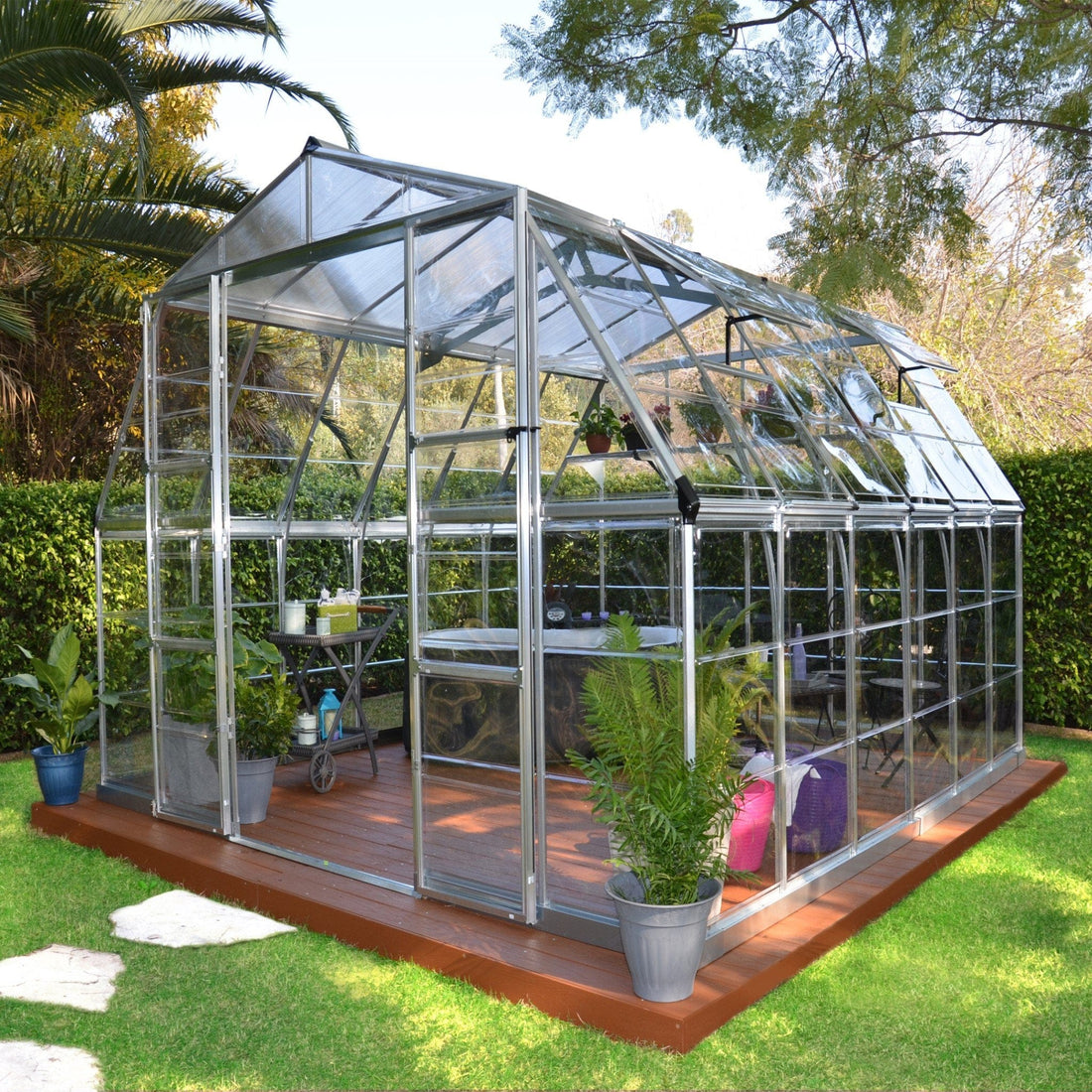Lexan (polycarbonate) and Plexiglass (acrylic) are both transparent plastic sheet materials, but Polycarbonate is significantly more impact-resistant and durable than Acrylic, while Acrylic offers better UV resistance and clarity retention.
Acrylic
Acrylic (sometimes called Plexiglass) is a type of thermoplastic material that is commonly used as a glazing material for greenhouses. It is lightweight, durable, and has excellent optical clarity.

Q: What are the advantages of using acrylic as a greenhouse glazing material?
A: Acrylic has several advantages as a greenhouse glazing material. Firstly, it is much more durable than glass and is able to withstand impacts and extreme weather conditions without cracking or shattering. Secondly, it is much lighter than glass, making it easier to install and reducing the load on the greenhouse frame. Thirdly, acrylic has excellent light transmission properties, allowing plenty of sunlight to pass through and promoting plant growth. Finally, acrylic has good insulation properties, which can help to keep the greenhouse warm and reduce heating costs.
Q: What are the different types of acrylic that are available for greenhouse glazing?
A: There are several different types of acrylic that are suitable for greenhouse glazing, including extruded acrylic and cast acrylic. Extruded acrylic is the most common type of acrylic and is available in a wide range of thicknesses and sizes. Cast acrylic is more expensive than extruded acrylic but has better optical clarity and is more resistant to scratching.
Q: How does acrylic compare to other greenhouse glazing materials, such as glass and polycarbonate?
A: Acrylic has several advantages over glass, including being much more durable, lighter, and more insulating. It also has better optical clarity and is less expensive than some types of glass. However, glass is more scratch-resistant than acrylic and has better UV resistance. Polycarbonate is also a popular greenhouse glazing material, especially for larger structures. Polycarbonate is lighter and much more impact-resistant than glass, but it is less optically clear than acrylic and can scratch more easily. Acrylic will also maintain optical clarity longer than polycarbonate. Acrylic, while durable and impact resistant (17 times stronger than glass), is more prone to cracking and shattering under impact than polycarbonate. Multi-wall polycarbonate (twin wall, triple wall, all the way up to five wall) is a more recent innovation and is known for its excellent insulating properties.
Q: How do I clean and maintain acrylic greenhouse glazing?
A: Acrylic is relatively easy to clean and maintain. You should avoid using harsh chemicals or abrasive materials, as these can scratch the surface of the acrylic. Instead, use a mild soap and water solution and a soft cloth or sponge to clean the surface of the acrylic. If the acrylic becomes scratched, it can be polished using a specialized acrylic polish. It is also important to remove any snow or ice that accumulates on the acrylic, as this can cause damage or reduce light transmission.
Polycarbonate
Polycarbonate, also sometimes known as Lexan, is a particular group of thermoplastic polymers that has many superior features in comparison with glass as well as with other polymers such as acrylic (Plexiglass). For example it is half the weight and 250 times stronger than typical glass, making it impact resistant and virtually unbreakable.

Here are some of the advantages and disadvantages of polycarbonate.
Key Advantages:
- Polycarbonate panels are virtually unbreakable and have exceptional impact resistance, being 250 times stronger than glass. This makes the material safer for many applications, especially when younger children or the elderly are involved. They are also highly resistant to vandalism or accidental breakage. This makes polycarbonate a great material for shelters, bike sheds, signs, and marine glazing. This is why modern sunglasses, bulletproof glass, DVDs, Blu-ray discs, computer cases, safety shields, phone cases, and so on are often polycarbonate.
- Polycarbonate withstands a wide range or temperatures, and can be flame and fire resistant and even fire retardant. Unlike acrylic sheets, flame retardant polycarbonate will not burn with an open flame and can actually be self-extinguishing. Polycarbonate's speed or quantity of smoke is absent or very low. Polycarbonate produces very few flaming droplets, which would contribute to the spread of fire by igniting other surfaces.
- Hard wearing and extremely durable, resistant to cracking and shattering, polycarbonate has a long service life. At the end of that life, the panels are fully recyclable.
- Polycarbonate has good resistance to many chemicals, including acids and gasoline.
- Polycarbonate retains heat very well and so is ideal for greenhouses. A polycarbonate greenhouse creates an optimal microclimate for your plants.
- Polycarbonate is light weight, making assembly and relocation of your kit much easier.
- Polycarbonate is easy to process and machine. It is processed similarly to acrylic sheet. Acrylic can melt if machined at too high a speed, but there is no chance of this with polycarbonate.
- Polycarbonate can be sawn, milled, engraved, drilled, bent (hot), glued, and polished in the same way as acrylic sheet.
- Polycarbonate panels have great optical clarity, yet protect everything inside a greenhouse from harmful UV rays, including shelving, plants, tools, and your skin.
Disadvantages:
- Polycarbonate is not resistant to scratches. If a branch should happen to fall on a patio canopy made of polycarbonate, it may be scratched. Scratches can be corrected somewhat by polishing the polycarbonate.
- Polycarbonate expands 0.065 mm per meter per degree Celsius. This has to be accounted for during manufacturing, and also when designing a structure so mounting holes or slide-channels are wide enough to prevent hardware from sticking as the panel expands and contrast. Any glue or sealant used on polycarbonate must be flexible.
- Polycarbonate can yellow when exposed to UV over time.
- Polycarbonate is generally more expensive than acrylic.
-- Note that these are general statements about polycarbonate and do not apply specifically to any particular products. Contact us for specific ratings if fire rating or other specifics are important considerations for your application.


